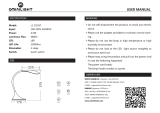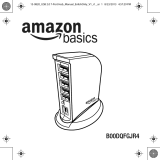
Chapter 3
Ways to Use the Media Hub
13
Media Hub
NOTE: Depending on the web browser you
are using, certificate or security warning
screens may appear. To continue with the
login process for remote access, accept the
warnings. For more information, refer to
Appendix A: Troubleshooting, page 44.
Enter the password you created during the Setup 4.
Wizard (the default is admin). Then click Submit.
On the 5. Media Browser screen, click Photos. Navigate to
the trip pictures.
Now you can view a slideshow of your trip pictures.
Download Videos Remotely
You want to share videos from your recent trip, but they
are stored on your Media Hub. Fortunately, you can access
your Media Hub over the Internet.
On your friends’ computer, open the web browser.1.
Go to 2. http://www.ciscomediahub.com.
Enter the remote device name of your Media Hub, and 3.
then click Go.
NOTE: Depending on the web browser you
are using, certificate or security warning
screens may appear. To continue with the
login process for remote access, accept the
warnings. For more information, refer to
Appendix A: Troubleshooting, page 44.
Enter the password you created during the Setup 4.
Wizard (the default is admin). Then click Submit.
On the 5. Media Browser screen, click File Browser.
Navigate to the trip videos. Then click the 6. Download
to PC option .
Now you can download the videos to your friends’
computer.
NOTE: Playing video files over remote access
requires the same plug-ins you have installed on
your home computer. Video playback support
over remote access depends on the broadband
speeds of both your home connection and
remote connection. Video playback should be
limited to smaller video files, as larger video
files may take a long time to load and play.
Upload Pictures Remotely
Your relatives have pictures from a recent family reunion.
The pictures are too large in size to send to your home
e-mail address, so you decide to upload them to your
Media Hub.
On your relatives’ computer, open the web browser.1.
Go to 2. http://www.ciscomediahub.com.
Enter the remote device name of your Media Hub, and 3.
then click Go.
NOTE: Depending on the web browser you
are using, certificate or security warning
screens may appear. To continue with the
login process for remote access, accept the
warnings. For more information, refer to
Appendix A: Troubleshooting, page 44.
Enter the password you created during the Setup 4.
Wizard (the default is admin). Then click Submit.
On the 5. Media Browser screen, click File Browser. Then
click the Upload to Media Hub option .
Now you can upload the photos to your Media Hub.
Setup of Remote Access Feature
When you enable and set up the remote access feature,
keep the following in mind:
Every Media Hub has a unique Remote Device Name. If •
the name you want to use is already taken, then try an
alternate name for your Media Hub.
For remote access, open your web browser. • Go to
http://www.ciscomediahub.com. When prompted,
enter the Remote Device Name and Password of your
Media Hub.
For more information, refer to Remote Access, page 41.
On-Demand Backups
Computers
NTI Shadow is the backup tool you installed during the
Setup Wizard. During installation, the Setup Wizard creates
a default backup job with the “On Demand” option selected.
(The default backup job also runs automatically.)
If you have backup jobs with the “On Demand” option
selected, then you can use the on-demand backup feature
of the Media Hub; for more information, refer to NTI
Shadow, page 31.
NOTE: Your computer(s) must be powered on
for the jobs to run.
For the Media Hub (NMH300 Series), you can press the
back up button on the front panel to initiate backup jobs.
For the Media Hub with LCD (NMH400 Series), you can use
the LCD menu to initiate backup jobs; refer to Backup,
page 27.























